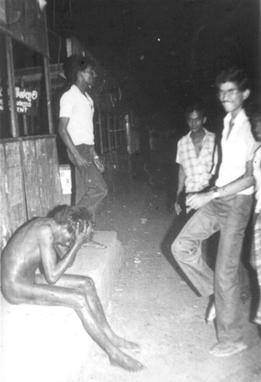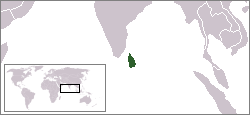| |||||
| Decades: | |||||
|---|---|---|---|---|---|
| See also: | |||||
The following lists events that happened during 1983 in Sri Lanka .
| |||||
| Decades: | |||||
|---|---|---|---|---|---|
| See also: | |||||
The following lists events that happened during 1983 in Sri Lanka .

The Liberation Tigers of Tamil Eelam was a Tamil militant organization, that was based in the northern and eastern Sri Lanka. The LTTE fought to create an independent Tamil state called Tamil Eelam in the northeast of the island in response to violent persecution and discriminatory policies against Sri Lankan Tamils by the Sinhalese-dominated Sri Lankan Government.

The Sri Lankan civil war was a civil war fought in Sri Lanka from 1983 to 2009. Beginning on 23 July 1983, it was an intermittent insurgency against the government by the Liberation Tigers of Tamil Eelam led by Velupillai Prabhakaran. The LTTE fought to create an independent Tamil state called Tamil Eelam in the north-east of the island for the Tamil Sri Lankans.

Velupillai Prabhakaran was a Tamil revolutionary. Prabhakaran was a major figure of Tamil nationalism, and the founder and leader of the Liberation Tigers of Tamil Eelam (LTTE). The LTTE was a militant organization that sought to create an independent Tamil state in the north and east of Sri Lanka in reaction to the oppression of the country's Tamil population by the Sri Lankan government. Under his direction, the LTTE undertook a military campaign against the Sri Lankan government for more than 25 years.

Indian Peace Keeping Force (IPKF) was the Indian military contingent performing a peacekeeping operation in Sri Lanka between 1987 and 1990. It was formed under the mandate of the 1987 Indo-Sri Lankan Accord that aimed to end the Sri Lankan Civil War between Sri Lankan Tamil militant groups such as the Liberation Tigers of Tamil Eelam (LTTE) and the Sri Lankan military.

Black July was an anti-Tamil pogrom that occurred in Sri Lanka during July 1983. The pogrom was premeditated, and was finally triggered by a deadly ambush on a Sri Lankan Army patrol by the Liberation Tigers of Tamil Eelam (LTTE) on 23 July 1983, which killed 13 soldiers. Although initially orchestrated by members of the ruling UNP, the pogrom soon escalated into mass violence with significant public participation.

Sathasivam Krishnakumar was a Sri Lankan Tamil rebel and leading member of the Liberation Tigers of Tamil Eelam, a separatist Tamil militant organisation in Sri Lanka.

The 1977 anti-Tamil pogrom in Sri Lanka followed the 1977 general elections in Sri Lanka where the Sri Lankan Tamil nationalistic Tamil United Liberation Front won a plurality of minority Sri Lankan Tamil votes. In the elections, the party stood for secession. An official government estimate put the death toll at 125, whereas other sources estimate that around 300 Tamils were killed by Sinhalese mobs. Human rights groups, such as the UTHR-J, accused the newly elected UNP-led government of orchestrating the violence.

The Kokkilai massacre was a massacre of Sinhalese civilians carried out by the Liberation Tigers of Tamil Eelam in the coastal village of Kokkilai. It was the group's second massacre of Sinhalese civilians.
The Anuradhapura massacre occurred in Sri Lanka in 1985 and was carried out by the Liberation Tigers of Tamil Eelam. This was the largest massacre of Sinhalese civilians by the LTTE to date; it was also the first major operation carried out by the LTTE outside a Tamil majority area. Initially, EROS claimed responsibility for the massacre, but it later retracted the statement, and joined the PLOTE in denouncing the incident. The groups later accused the LTTE for the attack. Since then, no Tamil militant group has admitted to committing the massacre. However, state intelligence discovered that the operation was ordered by the LTTE's leader Velupillai Prabhakaran. He assigned the massacre to the LTTE Mannar commander Victor and it was executed by Victor's subordinate Anthony Kaththiar. The LTTE claimed the attack was in revenge of the 1985 Valvettiturai massacre, where the Sri Lanka Army killed 70 Tamil civilians in Prabhakaran's hometown. In 1988, the LTTE claimed that the massacre was planned and executed under the guidance of Indian intelligence agency, RAW.
The October 1995 Eastern Sri Lanka massacres were a series of massacres of the Sinhalese population in the Eastern Province or Sri Lanka carried out by the Liberation Tigers of Tamil Eelam (LTTE) during the Sri Lankan Civil War.
Eelam War I is the name given to the initial phase of the armed conflict between the government of Sri Lanka and the LTTE.
Eelam War III is the name given to the third phase of armed conflict between the Sri Lankan military and the separatist Liberation Tigers of Tamil Eelam (LTTE).

The Jaffna hospital massacre occurred on October 21 and 22, 1987, during the Sri Lankan Civil War, when troops of the Indian Peace Keeping Force entered the premises of the Jaffna Teaching Hospital in Jaffna, Sri Lanka, an island nation in South Asia, and killed between 60 and 70 patients and staff. The rebel Liberation Tigers of Tamil Eelam, the government of Sri Lanka, and independent observers such as the University Teachers for Human Rights and others have called it a massacre of civilians.

The 1989 Valvettiturai massacre occurred on 2 and 3 August 1989 in the small coastal town of Valvettiturai, on the Jaffna Peninsula in Sri Lanka. Sixty-four Sri Lankan Tamil civilians were killed by soldiers of the Indian Peace Keeping Force. The massacre followed an attack on the soldiers by rebel Liberation Tigers of Tamil Eelam cadres. The rebel attack had left six Indian soldiers, including an officer, dead, and another 10 injured. Indian authorities claimed that the civilians were caught in crossfire. Journalists such as Rita Sebastian of the Indian Express, David Husego of the Financial Times and local human rights groups such as the University Teachers for Human Rights have reported quoting eyewitness accounts that it was a massacre of civilians. George Fernandes, who later served as defense minister of India (1998–2004), called the massacre India’s My Lai.

Madhu church shelling or Madhu church massacre is the name for the shelling of the Shrine of Our Lady of Madhu in Sri Lanka during the Sri Lankan civil war on November 20, 1999. The shelling resulted in the deaths of approximately 40 minority Sri Lankan Tamil civilians, including children, and more than 60 non-fatal injuries. The exact cause and nature of the event is disputed between the rebel Liberation Tigers of Tamil Eelam and the Sri Lankan government. According to Bishop Rayappu Joseph, the attack was carried out by the LTTE. The church is a Roman Catholic Marian shrine in Mannar district of Sri Lanka. With a history of over 400 years, this shrine acts as a center for pilgrimage and worship for Sri Lankan Catholics and others. The site is considered as the holiest Catholic shrine in the island.

The history of Sri Lanka from 1948 to the present is marked by the independence of the country through to Dominion and becoming a Republic.
The following lists events that happened during 1987 in Sri Lanka.

The 1987 Eastern Province massacres were a series of massacres of the Sinhalese population in the Eastern Province of Sri Lanka by Tamil mobs and Liberation Tigers of Tamil Eelam (LTTE) during the Sri Lankan Civil War. Though they began spontaneously, they became more organized, with the LTTE leading the violence. Over 200 Sinhalese were killed by mob and militant violence, and over 20,000 fled the Eastern Province. The violence has been described as having had the appearance of a pogrom, with the objective of removing Sinhalese from the Eastern Province.
The Thirunelveli massacre happened on July 24, 1983, following the killing of 13 Sri Lanka Army soldiers in an LTTE ambush in Thirunelveli the night before. In response to the ambush, truckloads of Sri Lankan soldiers left the Palaly camp at 4:30 AM, smashing all the shops on the way to Thirunelveli. Over 60 Tamil civilians in Jaffna were subsequently massacred by the rampaging army in revenge.